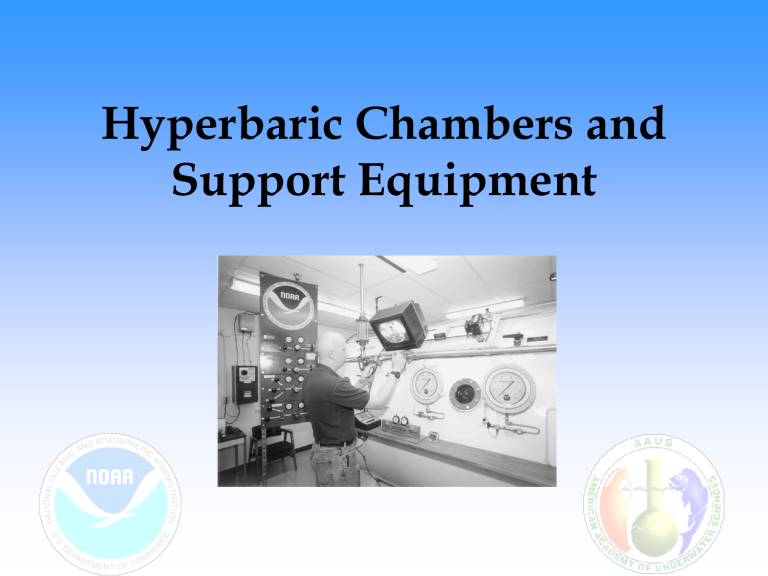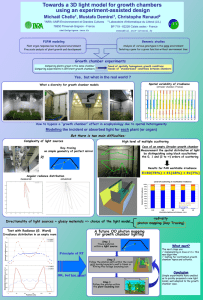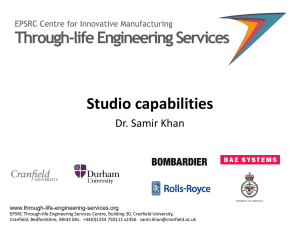Hyperbaric Chambers and Support Equipment

Hyperbaric Chambers and
Support Equipment
Sources
• Joiner, J.T. 2001. NOAA Diving Manual:
Diving for Science and Technology. Best
Publishing Co., Flagstaff, AZ.
Objectives
• Upon completion of this module, the participant will be able to:
– Describe the different uses of hyperbaric chambers
– Describe the different classifications of chambers
– List the minimum equipment to be found in a chamber
– Discuss the features of a transportable chamber
– List the minimum personnel required for a chamber treatment, and their primary responsibilities
– List the items found on a predive and postdive checklist
– Discuss the various types of chamber gas supplies
– Describe chamber ventilations procedures
– Describe how to determine the proper ventilation and gas calculation method
– Define the Built-in Breathing System
– Describe the types of gas analyzers used in chambers
– Describe NOAA chamber maintenance requirements
– Discuss fire prevention in chambers
Introduction
• Chambers can be used for surface decompression, omitted decompression, recompression of injured divers, training, research, and pressure testing of equipment
• Decompression chambers are primarily used for conducting surface decompression, and are often called deck decompression chambers (DDC)
• Recompression chambers are used to treat injured divers, with decompression illness or carbon monoxide poisoning
• Hyperbaric chamber literally means “high pressure chamber”
Chamber Standards and Certification
• Pressure Vessels for Human Occupancy (PVHO) is the nomenclature used by the American Society for
Mechanical Engineering (ASME)
• The standard, ASME PVHO-1, deals with the materials, design, and manufacturing of the pressure vessel
• The National Fire Protection Association has guidelines
(NFPA 99) that deal with hyperbaric chambers
• The Association of Diving Contractors International
(ADCI) publishes a consensus standard which addresses how chambers should be outfitted and deployed for commercial diving operations
Chamber Standards and Certification
(cont)
• NFPA classifies chambers as the following:
– Class A, or multi-place chambers are built for occupancy by more than one person
• One compartment can be pressurized to depth while another can be left at surface pressure
• This allows tenders or physicians to be pressurized into the main compartment as needed and then lock back out to the surface as needed
• A medical lock is a small extension of the main compartment which may be pressurized separately for transferring meals, fluids, etc.
– Class B, or monoplace chambers are built for occupancy by only one person. These are more typically used in hospital settings
– Class C, or animal chambers are built for conducting research or treating animals
Chamber Equipment
• At a minimum, chambers should be equipped with the following:
– Pressurization and exhaust systems
– Viewports
– Depth control gauges and control manifolds
– A two-way communication system
– Built-in breathing system (BIBS) for the delivery of oxygen
– Gas monitoring ports
– Stop watches, or some system of tracking elapsed time
– Illumination system
– Fire suppression system
– Environmental control systems for heating and cooling
Transportable Chambers
• Small, lightweight, portable chambers have been available since the 1960s
• Minimal gas requirements mean they can usually be operated with a few scuba cylinders and an adequate supply of oxygen
• Modern materials such as Kevlar, stainless steel, and titanium have been used
• “NATO” flange allows for locking to another chamber
Transportable Chambers (cont)
• A “hyperbaric stretcher” is a low-cost monoplace chamber which can be stored into two footlocker size boxes
Chamber Operations
The personnel required for conducting a recompression operation may include:
1. Chamber Supervisor. Has overall responsibility for all aspects of the treatment
2. Inside Tender. Must be familiar with the diagnosis of divingrelated injuries and illnesses. Responsible for releasing door latches, providing first aid, administering oxygen, ensuring that ear protection is worn, maintaining a clean chamber, and ensuring proper switch from air to O
2
3. Outside Tender. Responsible for maintaining and controlling the air supply, keeping the dive log, communicating with inside personnel, decompressing inside personnel, and pressurizing, ventilating, and exhausting the chamber
4. Diving Physician. Trained in the treatment of diving injuries. May be available via telephone
Chamber Operations (cont)
• A diving physician or diver medic should be present during recompression treatments
Chamber Operations (cont)
• Predive and postdive checklists should be used for chamber operations (see NOAA Diving Manual Tables 18.2 and 18.3)
– Predive checklists should contain items such as:
Air supply system Oxygen supply system
Nitrox
Communication system
Miscellaneous-inside chamber
Electrical system
Fire prevention system
Miscellaneous-outside chamber
Closed-circuit operations Chamber, overall
– Postdive checklists should contain items such as:
Air supply
Chamber, overall
Oxygen supply
Communications
Viewports and doors
Support items
Nitrox supply
Electrical
• A separate checklist should be prepared for each team position
Chamber Gas Supply
Primary supply: sufficient air to pressurize the chamber to twice the maximum treatment depth and to ventilate throughout the treatment
Secondary supply: sufficient air to pressurize the chamber once to the maximum treatment depth and to ventilate throughout the treatment
Emergency supply: where feasible and practical, a third emergency gas supply should be available which will provide sufficient gas to ventilate the chamber and do a minimum number of compartment runs
• Gases may be provided by any combination of stored and compressor capacities, but the emergency supply should be stored high-pressure gas only
Chamber Ventilation and Gas Calculations
• It is necessary to ventilate the chamber with a fresh supply of air, unless it is equipped with a scrubber
• The rate of ventilation depends on the number of personnel in the chamber, and their activity level
• Generally, 3 scfm per person is adequate to support occupants at rest
• If the occupants are breathing oxygen by mask without overboard dump, 13 scfm is recommended fore each occupant at rest and 25 scfm for every occupant that is active
Chamber Ventilation and Gas
Calculations (cont)
• The ventilation rate can be calculated using the following formula:
R = V X 18 t x (P + 33)
33
Where
R= chamber ventilation rate in acfm
V= volume of chamber in cubic feet t= time, in seconds, for the chamber pressure to change 10 fsw
P= chamber pressure (gauge) in fsw
Chamber Ventilation and Gas
Calculations (cont)
• To determine R, compress the chamber to 5 fsw below the intended range to be measured, then initiate decompression and time the interval as the chamber passes through the depths
• For example, to determine the valve setting at 60 fsw use the following sequence:
1.
Compress the chamber to 70 fsw, stabilize the pressure and temperature, and secure the vent
2.
Initiate decompression
3.
Begin timing the chamber ascent as it passes through 65 fsw
4.
End timing the chamber ascent as it passes through 55 fsw
5.
Terminate the ascent
• Apply the results into the equation, and if the ventilation rate is inadequate, adjust the valve position and continue to experiment until an appropriate setting is found
Notes on Chamber Ventilation
• If air is reasonably plentiful, more air than specified can be used for comfort
• There is seldom any danger of having too little oxygen in the chamber when using air for ventilation
• Good air circulation is important. Locating the inlet near one end of the chamber and the outlet near the other end improves ventilation
• Coming up to the next stop reduces the standard cubic feet of gas in the chamber and proportionally reduces the quantity (scfm) of air required for ventilation
• Continuous ventilation is the most efficient method of ventilation in terms of the amount of air required. The continuous noise may require hearing protection
• The size of the chamber does not influence the rate (acfm) required for ventilation
• Increasing depth increases the actual mass of air required for ventilation
• If high-pressure air banks are being used for the chamber supply, pressure changes in the cylinders can be used to check the amount of ventilation being provided
Built-In-Breathing System (BIBS)
• This mask breathing system provides breathing gas (usually oxygen) to the chamber occupant
• BIBS can either dump its exhaust into the chamber, or be plumbed for overboard dump. Non-overboard dump BIBS can rapidly cause extreme increases in the ambient oxygen levels inside the chamber
• The oral-nasal mask provides breathing gas on demand, and obstructs the exchange of gas with the surrounding medium
Gas Analyzers
• Oxygen analyzers are useful for monitoring oxygen concentrations in chambers where oxygen is used for therapy, surface decompression, or research
– The oxygen level in a hyperbaric chamber should be maintained between 21-23% to reduce the danger of a fire
– Oxygen analyzers are also useful in monitoring the breathing gas supplied to BIBS
• Carbon monoxide analyzers can be mounted on the air supply to ensure the quality of the air supply
– Some newer systems monitor CO concentrations downstream in the delivery system and have automatic shutdowns on the compressor in cases where high CO concentrations are detected
Electrical Systems
• Whenever possible, it is best to keep all electricity outside of the chamber
• Lights can usually be provided through fiber optics or port windows
• Newer, low level electronics, such as battery-powered communications, cameras, ECG leads, and defibrillation pads are found in some chambers
• Chambers must be electrically grounded
• Whenever practical, 110 voltage alternating current (AC) should be isolated from contact with any chamber component. Twelve or 24 volt DC systems are preferable
Chamber Maintenance
• Proper care of a hyperbaric chamber requires both routine and periodic maintenance
– After every use, or no less than once a month, the chamber should be checked and minor repairs should be made and supplies restocked
– At least twice a year, the chamber should be inspected inside and out, cleaned of any grease, dust or other dirt and repainted as appropriate
Chamber Maintenance
(cont)
• All NOAA chambers must be pneumatically pressure tested annually
Fire Prevention
• Hyperbaric chambers pose a special fire hazard because of the increased flammability of materials in compressed air
• The traditional trio of conditions necessary for a fire are:
1.
A source of ignition; matches, lighters and gas hand warmers are inappropriate for use inside chambers
2.
Combustible materials; must be limited and should be kept in a closed stainless steel container
3.
Oxygen; is present in an enriched form as part of the pressurized air
Fire Protection Precautions
• Maintain oxygen concentration and partial pressure as low as possible. Use an overboard dump system whenever high PO
2 mixtures are being employed
• Eliminate ignition sources
• Minimize combustibles, with the complete exclusion of flammable liquids and gases
• If combustible materials must be employed, the type and quantity must be carefully controlled
• The extinguishment system must be water-based and include not only a deluge system, but a hand-line as well. The deluge should be controllable from both inside and outside the chamber
• A BIBS mask, with a breathable gas on-line, should be available for every chamber occupant
• Escape to another chamber or directly into the sea should be the first option in the fire safety operations plan, whenever feasible








